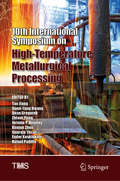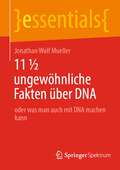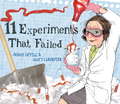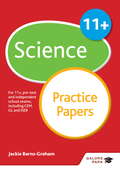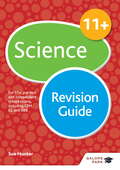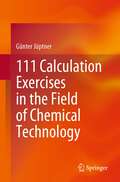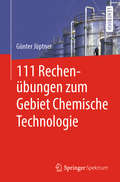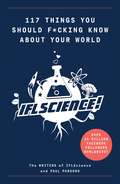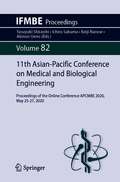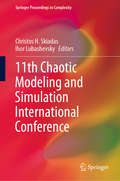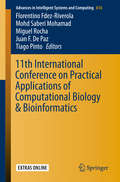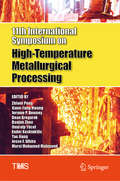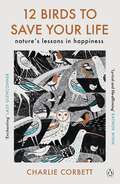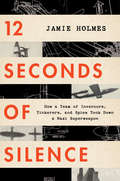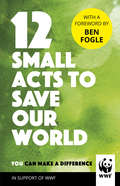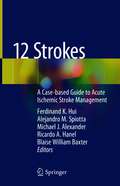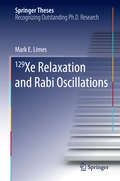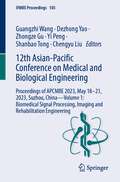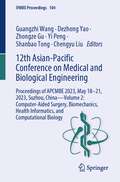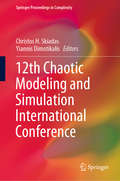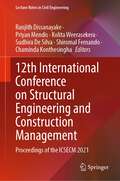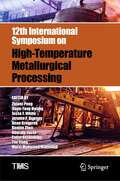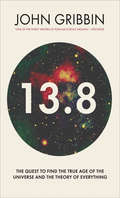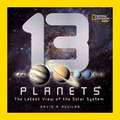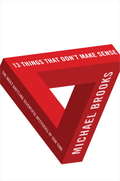- Table View
- List View
10th International Symposium on High-Temperature Metallurgical Processing (The Minerals, Metals & Materials Series)
by Tao Jiang Jiann-Yang Hwang Dean Gregurek Zhiwei Peng Jerome P. Downey Baojun Zhao Onuralp Yücel Ender Keskinkilic Rafael PadillaIn recent years, global metallurgical industries have experienced fast and prosperous growth. High-temperature metallurgical technology is the backbone to support the technical, environmental, and economical needs for this growth. This collection features contributions covering the advancements and developments of new high-temperature metallurgical technologies and their applications to the areas of processing of minerals; extraction of metals; preparation of refractory and ceramic materials; sintering and synthesis of fine particles; treatment and recycling of slag and wastes; and saving of energy and protection of environment. The volume will have a broad impact on the academics and professionals serving the metallurgical industries around the world.
11 ½ ungewöhnliche Fakten über DNA: oder was man auch mit DNA machen kann (essentials)
by Jonathan Wolf MuellerDNA ist das Material von Krimis, Archäologie und Vaterschaftsklagen. Spätestens seit Corona-PCR-Tests sind Nucleinsäuren im wahrsten Sinne des Wortes „in aller Munde“. Dieses Springer-essential beschäftigt sich damit, was man auch mit DNA machen kann. Meist sind diese Dinge ungewöhnlich, manchmal high-tech, hoffentlich lehrreich und eventuell sogar amüsant. Vielleicht ist dieser Band ja eine Anregung für Sie, DNA aus einer anderen Perspektive zu sehen.
11 Experiments That Failed
by Jenny Offill Nancy Carpenter"This is a most joyful and clever whimsy, the kind that lightens the heart and puts a shine on the day," raved Kirkus Reviews in a starred review.Is it possible to eat snowballs doused in ketchup--and nothing else--all winter? Can a washing machine wash dishes? By reading the step-by-step instructions, kids can discover the answers to such all-important questions along with the book's curious narrator. Here are 12 "hypotheses," as well as lists of "what you need," "what to do," and "what happened" that are sure to make young readers laugh out loud as they learn how to conduct science experiments (really!). Jenny Offill and Nancy Carpenter--the ingenious pair that brought you 17 Things I'm Not Allowed to Do Anymore--have outdone themselves in this brilliant and outrageously funny book.From the Hardcover edition.
11+ Science Practice Papers: For 11+, pre-test and independent school exams including CEM, GL and ISEB
by Jackie Barns-GrahamExam Board: ISEBLevel: 11 PlusSubject: ScienceFirst Teaching: September 2015First Exam: Autumn 2018Prepare for the most challenging of pre-tests and 11 plus independent school entrance exams with five levelled exam papers designed to test pupils' ability across all Science topics for a better chance at getting into their school of choice.- Develops and perfects exam technique for all major pre-test and 11 plus independent school exams including ISEB- Features levelled papers to help build skills for the top marks - Teaches pupils to improve their response rates with timed papers- Builds exam-room confidence by practising with a variety of exam paper styles- Identifies weaker areas and improves results with detailed answers and commentary- Prepares pupils for what they will face on exam day with a mock testAlso available for 11 Plus Science preparation: - 11 Plus Science Revision Guide ISBN 9781471849237Revision Guides, Workbooks and Practice Papers are also available for Maths, English, Verbal Reasoning and Non-Verbal Reasoning on www.galorepark.co.uk
11+ Science Revision Guide: For 11+, pre-test and independent school exams including CEM, GL and ISEB
by Sue HunterExam Board: ISEBLevel: 11 PlusSubject: ScienceFirst Teaching: September 2015First Exam: Autumn 2018Secure the top marks in 11 plus independent school entrance exams and pre-tests and a better chance at getting into their school of choice with this essential revision guide. Complete coverage of the ISEB 11 Plus Science syllabus and stretching extra content ensures that every topic is thoroughly revised ahead of the exams.- This book covers everything required for the 11 Plus Science exam- Prepares pupils for a wide range of independent school exams and pre-tests with challenging extension material- Consolidates revision with all the key information in one place- Features helpful insight in to the exams, with examples, practical tips and advice- Tests understanding and technique with timed, levelled exam-style questionsAlso available for 11 Plus Science preparation: - 11 Plus Science Practice Papers ISBN 9781471849282Revision Guides, Workbooks and Practice Papers are also available for English, Maths, Verbal Reasoning and Non-Verbal Reasoning on www.galorepark.co.uk.
111 Calculation Exercises in the Field of Chemical Technology
by Günter JüptnerEveryday use in chemical production operations requires a complex bundle of basic knowledge for calculating various operating parameters and variables. This includes the application of mass and heat balances, the ideal gas law, the mass action law and electrochemistry. In addition, there are calculations for the pumping of liquids and for scale enlargement. The present work covers this subject area in a clear manner in the form of exercises. The author knows from many years of practical experience that such calculations are often not isolated problems, but complex issues in which various subject areas are coupled together. This fact is taken into account in this exercise book. It presents in a short and concise form the everyday challenges of calculations in a chemical plant and offers ways of solving them. Special basic operations are not treated, and reference is made to special works that treat such topics in detail. This exercise book offers the possibility of deepening the knowledge of solving the calculations that occur daily in a chemical production plant.
111 Rechenübungen zum Gebiet Chemische Technologie
by Günter JüptnerDer alltägliche Einsatz im chemischen Produktionsbetrieb erfordert ein komplexes Bündel an Grundkenntnissen zur Berechnung verschiedener Betriebsparameter und -größen. Hierzu zählen als Schwerpunkt die Anwendung von Massen- und Wärmebilanzen, des idealen Gasgesetzes, sowie des Massenwirkungsgesetzes und der Elektrochemie. Zusätzlich fallen noch Berechnungen zum Verpumpen von Flüssigkeiten und zur Maßstabsvergrößerung an. Das vorliegende Werk erfasst diesen Themenkreis in übersichtlicher Weise in Form von Übungsaufgaben. Der Autor weiß aus langjähriger praktischer Erfahrung, dass solche Berechnungen oft nicht als isolierte Probleme, sondern als komplexe Fragestellung vorliegen, in der verschiedene Sachgebiete miteinander gekoppelt sind. Diesem Fakt wird in dem vorliegenden Übungsbuch Rechnung getragen. Es stellt in kurzer und prägnanter Form die alltäglichen Herausforderungen von Berechnungen in einem Chemiebetrieb dar und bietet Lösungswege an. Auf die Behandlung spezieller Grundoperationen wird verzichtet und auf spezielle Werke hingewiesen, die solche Themen ausführlich behandeln. Das vorliegende Übungsbuch bietet die Möglichkeit der Vertiefung der Kenntnisse zur Lösung der in einem chemischen Produktionsbetrieb täglich anfallenden Berechnungen.
117 Things You Should F*#king Know About Your World: The Best of IFL Science
by IflscienceDid you know your irises are lying to you and all human eyes are actually brown?Want to know the absolute worst way to die, according to science? Did you know that a smoking psychedelic toad milk could alleviate depression for up to four weeks?117 Things You Should F*#king Know About Your World tells you the answers to these questions and many more weird and wonderful facts about the universe. Split into the site's different subject areas of environment, technology, space, health and medicine, plants and animals, physics and chemistry, this is the ultimate science book. With 25 million social media followers, I F*#king Love Science is the world's favourite source of science on the web. From missing nuclear weapons and Facebook secret files to the world's smallest computer and why you should wrap your car keys in tinfoil, this is the book that only the world's leading source of crazy-but-true stories could produce.
11th Asian-Pacific Conference on Medical and Biological Engineering: Proceedings of the Online Conference APCMBE 2020, May 25-27, 2020 (IFMBE Proceedings #82)
by Yasuyuki Shiraishi Ichiro Sakuma Keiji Naruse Akinori UenoThis book presents cutting-edge research and developments in the field of medical and biological engineering, which a special emphasis on activities carried out in the Asian-Pacific region. Gathering the proceedings of the 11th Asian-Pacific Conference on Medical and Biological Engineering, organized in Japan and held online on May 25-27, 2020, the book both fundamental research and clinical applications relating to medical instrumentations, bioimaging, bioinformatics and computational biomedicine, AI and data science in healthcare, as well as regenerative medicine and rehabilitation. It aims at informing on new trends, challenges and solutions, and fosters communication and collaboration between medical scientists, engineers, and researchers dealing with cutting-edge themes in broad field of biomedical and clinical engineering.
11th Chaotic Modeling and Simulation International Conference (Springer Proceedings in Complexity)
by Christos H. Skiadas Ihor LubashevskyGathering the proceedings of the 11th CHAOS2018 International Conference, this book highlights recent developments in nonlinear, dynamical and complex systems. The conference was intended to provide an essential forum for Scientists and Engineers to exchange ideas, methods, and techniques in the field of Nonlinear Dynamics, Chaos, Fractals and their applications in General Science and the Engineering Sciences. The respective chapters address key methods, empirical data and computer techniques, as well as major theoretical advances in the applied nonlinear field. Beyond showcasing the state of the art, the book will help academic and industrial researchers alike apply chaotic theory in their studies.
11th International Conference on Practical Applications of Computational Biology & Bioinformatics (Advances in Intelligent Systems and Computing #616)
by Florentino Fdez-Riverola Juan F. De Paz Mohd Saberi Mohamad Miguel Rocha Tiago PintoBiological and biomedical research are increasingly driven by experimental techniques that challenge our ability to analyse, process and extract meaningful knowledge from the underlying data. The impressive capabilities of next-generation sequencing technologies, together with novel and constantly evolving, distinct types of omics data technologies, have created an increasingly complex set of challenges for the growing fields of Bioinformatics and Computational Biology. The analysis of the datasets produced and their integration call for new algorithms and approaches from fields such as Databases, Statistics, Data Mining, Machine Learning, Optimization, Computer Science and Artificial Intelligence. Clearly, Biology is more and more a science of information and requires tools from the computational sciences. In the last few years, we have seen the rise of a new generation of interdisciplinary scientists with a strong background in the biological and computational sciences. In this context, the interaction of researchers from different scientific fields is, more than ever, of foremost importance in boosting the research efforts in the field and contributing to the education of a new generation of Bioinformatics scientists. The PACBB'17 conference was intended to contribute to this effort and promote this fruitful interaction, with a technical program that included 39 papers spanning many different sub-fields in Bioinformatics and Computational Biology. Further, the conference promoted the interaction of scientists from diverse research groups and with a distinct background (computer scientists, mathematicians, biologists).
11th International Symposium on High-Temperature Metallurgical Processing (The Minerals, Metals & Materials Series)
by Dean Gregurek Baojun Zhao Tao Jiang Jiann-Yang Hwang Zhiwei Peng Onuralp Yücel Ender Keskinkilic Jerome P. Downey Morsi Mohamed Mahmoud Jesse F. WhiteIn recent years, global metallurgical industries have experienced fast and prosperous growth. High-temperature metallurgical technology is the backbone to support the technical, environmental, and economical needs for this growth. This collection features contributions covering the advancements and developments of new high-temperature metallurgical technologies and their applications to the areas of processing of minerals; extraction of metals; preparation of refractory and ceramic materials; sintering and synthesis of fine particles; treatment and recycling of slag and wastes; and saving of energy and protection of environment. The volume will have a broad impact on the academics and professionals serving the metallurgical industries around the world.
12 Birds to Save Your Life: Nature's Lessons in Happiness
by Charlie CorbettDiscover the healing power of nature through the stories of these characterful birds, whose song is never far away . . .LONGLISTED FOR THE 2022 WAINWRIGHT PRIZE'A lyrical and life-affirming book that teaches us as much about birds as it does ourselves - a balm for the soul' Raynor Winn, author of The Salt Path'Totally absorbing and completely engaging on so many levels . . . Charlie has opened my eyes to the constant joy of the sights and sounds of the birds that surround us. It is a book that really will save lives' Dr Richard Shepherd, author of Unnatural Causes_________After the tragic loss of his mother, Charlie Corbett felt trapped by his pain. Having lost all hope and perspective he took to the countryside in search of solace. There, he heard the soaring, cascading song of the skylark - a sound that pulled him from the depths of despair and into the calm of the natural world.Weaving his journey through grief with a remarkable portrait of the birds living right on our doorstep, 12 Birds to Save Your Life is an invitation to stop, step outside, and listen. By following Charlie's path, opening your eyes and ears to what has been there all along, you will discover how nature can set you free.
12 Seconds of Silence: How a Team of Inventors, Tinkerers, and Spies Took Down a Nazi Superweapon
by Jamie HolmesThe riveting story of the American scientists, tinkerers, and nerds who solved one of the biggest puzzles of World War II—and developed one of the most powerful weapons of the war 12 Seconds of Silence is the remarkable, lost story of how a ragtag group of American scientists overcame one of the toughest problems of World War II: shooting things out of the sky. Working in a secretive organization known as Section T, a team of physicists, engineers, and everyday Joes and Janes took on a devilish challenge. To help the Allies knock airplanes out of the air, they created one of the world&’s first &“smart weapons.&” Against overwhelming odds and in a race against time, mustering every scrap of resource, ingenuity, and insight, the scientists of Section T would eventually save countless lives, rescue the city of London from the onslaught of a Nazi superweapon, and help bring about the Axis defeat. A holy grail sought after by Allied and Axis powers alike, their unlikely innovation ranks with the atomic bomb as one of the most revolutionary technologies of the Second World War. Until now, their tale was largely untold. For fans of Erik Larson and Ben Macintyre, set amidst the fog of espionage, dueling spies, and the dawn of an age when science would determine the fate of the world, 12 Seconds of Silence is a tribute to the extraordinary wartime mobilization of American science and the ultimate can-do story.
12 Small Acts to Save Our World: Simple, Everyday Ways You Can Make a Difference
by WWF_______________________________— Ever wanted to save the world? —It’s easy to feel like we can’t make a difference. But small, easy actions, if taken by enough people, can move mountains – and save planets.Written in collaboration with leading environmental experts from WWF, this short book provides simple changes we can all make to our everyday lives, from morning to night.These aren’t the only things you can do. Nor are they things you have to do. But these 12 small acts are basic steps anybody can take, and if even one of them sticks, our children will inherit a better world.Acts like:– Turning off devices instead of leaving them on standby– Buying less cotton clothing (a T-shirt needs 2,400 litres of water to make!)– Using reusable straws when possible– Turning off the tap while you brush your teethwill take only moments, but if enough people commit to them, we can make a real difference to our planet._______________________________'Now really is the time to act. You don’t have to be a superhero – everyone can make a difference by following this book’ – Ben Fogle
12 Strokes: A Case-based Guide to Acute Ischemic Stroke Management
by Ferdinand K. Hui Alejandro M. Spiotta Michael J. Alexander Ricardo A. Hanel Blaise William BaxterThis comprehensive, case-based resource provides the state-of-the-art knowledge that can help readers improve access and optimize delivery of stroke thrombectomy. Improving access to stroke is of particular importance because patients often misinterpret their symptoms or cannot speak for themselves if they have aphasia. More importantly, access needs to be organized because stroke therapies are all extremely time-sensitive. Scalable, choreographed protocols are necessary for emergency medical systems to ‘capture’ stroke patients and automatically transport and triage to time-sensitive treatments. Many of the chapters in the first section on Fundamentals and Systems provide valuable insight in improving access to stroke care. Replete with illustrative case studies and emphasizing that treatment approaches to stroke should not be comprised of a one-size-fits-all approach, this illuminating title provides the complete thought, detail, insight and organization that will help readers meet the needs of stroke patients with large vessel occlusions. 12 Strokes: A Case-based Guide to Acute Ischemic Stroke Management examines the primary technical principles that underlie the current thrombectomy approaches. Instead of continuing the conceptual dichotomy of stent vs. aspiration, many of the chapters look at underlying principles and then discuss ways in which the currently available devices and approaches can best exploit them. The variety, creativity and detail in many of these chapters will help the reader develop a deeper understanding that might assist their ability to successfully take care of their next patient that ‘doesn’t follow the textbook.’ In addition, the anatomic and pathophysiologic classification of the core Twelve Chapters will help readers organize their thinking and approach. This knowledge, particularly because it is organized based on common, challenging syndromes, will arm the reader to quickly recognize patterns and deftly adapt their management approaches to the needs of the patient. An invaluable contribution to the clinical literature, 12 Strokes: A Case-based Guide to Acute Ischemic Stroke Management will be of great interest to not only neurosurgeons and neurologists but other specialists, primary care providers, and trainees as well.
129 Xe Relaxation and Rabi Oscillations (Springer Theses)
by Mark E. LimesThis thesis describes longitudinal nuclear relaxation measurements of solid 129Xe near 77 K with previously unattainable reproducibility, and demonstrates differences in relaxation, dependent upon the way in which the solid is condensed. These results are directly applicable to the generation and storage of large quantities of hyperpolarized 129Xe for various applications, such as lung magnetic resonance imaging (MRI). The thesis features a sophisticated theoretical approach to these data sets, including modifications to a well-established Raman-phonon scattering theory that may explain the larger scatter in and discrepancies with previous work.
12th Asian-Pacific Conference on Medical and Biological Engineering: Proceedings of APCMBE 2023, May 18–21, 2023, Suzhou, China—Volume 1: Biomedical Signal Processing, Imaging and Rehabilitation Engineering (IFMBE Proceedings #103)
by Guangzhi Wang Dezhong Yao Zhongze Gu Yi Peng Shanbao Tong Chengyu LiuThis book presents cutting-edge research and developments in the field of medical and biological engineering, which a special emphasis on activities carried out in the Asian-Pacific region. Gathering the proceedings of the 12th Asian-Pacific Conference on Medical and Biological Engineering (APCMBE 2023), held on May 18–21, 2023, in Suzhou, China, this first volume of a two-volume set focuses on biomedical imaging and signal processing, biomedical sensing and wearables, and rehabilitation and neural engineering. All in all, this book offers extensive information on the state-of-the-art solutions and challenges in biomedical and clinical engineering, addressing a broad audience of medical scientists, engineers, physicists and other researchers and professionals.
12th Asian-Pacific Conference on Medical and Biological Engineering: Proceedings of APCMBE 2023, May 18–21, 2023, Suzhou, China—Volume 2: Computer-Aided Surgery, Biomechanics, Health Informatics, and Computational Biology (IFMBE Proceedings #104)
by Guangzhi Wang Dezhong Yao Zhongze Gu Yi Peng Shanbao Tong Chengyu LiuThis book presents cutting-edge research and developments in the field of medical and biological engineering, which a special emphasis on activities carried out in the Asian-Pacific region. Gathering the proceedings of the 12th Asian-Pacific Conference on Medical and Biological Engineering (APCMBE 2023), held on May 18–21, 2023, in Suzhou, China, this second volume of a two-volume set covers advances in computer-aided surgery, biomechanics and micro-nanoengineering, health informatics and health engineering, as well as computational modeling and simulation, as well as AI applications in biology and medicine. It addresses a broad audience of researchers and professionals active in biomedical engineering, biomechanics, medical biophysics, and health informatics.
12th Chaotic Modeling and Simulation International Conference (Springer Proceedings in Complexity)
by Christos H. Skiadas Yiannis DimotikalisGathering the proceedings of the 12th CHAOS2019 International Conference, this book highlights recent developments in nonlinear, dynamical and complex systems. The conference was intended to provide an essential forum for Scientists and Engineers to exchange ideas, methods, and techniques in the field of Nonlinear Dynamics, Chaos, Fractals and their applications in General Science and the Engineering Sciences. The respective chapters address key methods, empirical data and computer techniques, as well as major theoretical advances in the applied nonlinear field. Beyond showcasing the state of the art, the book will help academic and industrial researchers alike apply chaotic theory in their studies.
12th International Conference on Structural Engineering and Construction Management: Proceedings of the ICSECM 2021 (Lecture Notes in Civil Engineering #266)
by Ranjith Dissanayake Priyan Mendis Kolita Weerasekera Sudhira De Silva Shiromal Fernando Chaminda KonthesinghaThis book highlights advances in the fields of civil engineering and construction industry with a particular focus on Structural Engineering and Construction Management. This book consists of top quality and innovative research papers selected from the proceedings of the 12th ICSECM 2021 under the themes of Innovations in Building Materials, Construction Management, Tall buildings, Concrete Technology and High Performance concrete, Geotechnical Engineering, Water and Waste Water Treatment, CKDu problem in Sri Lanka, Structural Health Monitoring & Design of Resistive Structures, Disaster Risk Reduction and Resilience in the Built Environment, Fibre Reinforced Polymer, Life Cycle Assessment of Buildings and Fire Safety Engineering.
12th International Symposium on High-Temperature Metallurgical Processing (The Minerals, Metals & Materials Series)
by Dean Gregurek Baojun Zhao Tao Jiang Jiann-Yang Hwang Zhiwei Peng Onuralp Yücel Ender Keskinkilic Jerome P. Downey Morsi Mohamed Mahmoud Jesse F. WhiteThis collection includes the analysis, development, and operation of high-temperature processes that involve the extraction and processing of material resources, production, and treatment of metals, alloys, and ceramic materials. Contributions describe innovative methods for achieving property enhancement, impurity segregation and removal, byproduct recovery, waste minimization, energy efficiency, and utilization of complex ores. Also included are various technical, economic, and environmental issues associated with commercial-scale high-temperature processing methods.
13.8: The Quest to Find the True Age of the Universe and the Theory of Everything
by John GribbinThe bestselling author of The Scientists presents &“alively and accessible look at how astronomers determined the age of our universe&” (Publishers Weekly, starred review). The twentieth century gave us two great theories of physics. The general theory of relativity describes the behavior of very large things, and quantum theory the behavior of very small things. In this landmark book, John Gribbin—one of the best-known science writers of the past thirty years—presents his own version of the Holy Grail of physics, the search that has been going on for decades to find a unified &“Theory of Everything&” that combines these ideas into one mathematical package, a single equation that could be printed on a T-shirt, containing the answer to life, the Universe, and everything. With his inimitable mixture of science, history, and biography, Gribbin shows how—despite skepticism among many physicists—these two great theories are very compatible, and point to a deep truth about the nature of our existence. The answer lies, intriguingly, with the age of the universe: 13.8 billion years. &“Gribbin is a confident, engaging guide . . . a lovingly rendered history.&”—The Wall Street Journal &“An exciting chronicle of a monumental scientific accomplishment by a scientist who participated in the measuring of the age of the universe.&”—Kirkus Reviews &“A book that hits readers with unrelenting detail. And with a story as grand as this one, that&’s exactly the way a good science book should have it. Nothing will be lost here, and everything—a clear understanding—will be gained.&”—Astronomy &“A welcome and relatively quick read for cosmology buffs, students, and amateur astronomers.&”—Booklist
13 Planets: The Latest View of the Solar System
by David A. AguilarFirst, Pluto left. Then it came back, along with Ceres and Eris. . . and now Haumea and MakeMake, too! The recent actions of the International Astronomical Union have put every solar system book out of date. In response, National Geographic joins forces with David Aguilar of the Harvard Smithsonian Astronomical Observatory to revise our 2008 book--and to update young readers on the high-interest topic of space. Using simple text and spectacular photorealistic computer art by the author, this book profiles all 13 planets in their newly created categories--plus the sun, the Oort Cloud, comets, and other worlds being discovered. Back-of-the-book activities offer hands-on fun for budding astronomers.
13 Things That Don't Make Sense: The Most Baffling Scientific Mysteries of Our Time
by Michael BrooksSpanning disciplines from biology to cosmology, chemistry to psychology to physics, Michael Brooks thrillingly captures the excitement of scientific discovery.Science’s best-kept secret is this: even today, thereare experimental results that the most brilliant scientists cannot explain. In the past, similar “anomalies” have revolutionized our world. If history is any precedent, we should look to today’s inexplicable results to forecast the future of science. Michael Brooks heads to the scientific frontier to confront thirteen modern-day anomalies and what they might reveal about tomorrow’s breakthroughs.From the Trade Paperback edition.
